Multi-Walled Carbon Nanotube Array Modified Electrode with 3D Sensing Interface as Electrochemical DNA Biosensor for Multidrug-Resistant Gene Detection
Abstract
1. Introduction
2. Materials and Methods
2.1. Chemicals and Reagents
2.2. Preparation of Carboxylic MWCNTs
2.3. Preparation of Amino-Modified AuE
2.4. Preparation of MWCNTs/AuE
2.5. Preparation of ssDNA/MWCNTs/AuE
2.6. Hybridization of the DNA Biosensor
2.7. Instrument and Apparatus
2.8. Quantitative Analysis of Chronocoulometry
3. Results and Discussion
3.1. Morphology Characterization of MWCNTs/AuE
3.2. Electrochemical Characterization
3.3. RuHex and Quantitative Analysis of Chronocoulometry
3.4. Signal Amplification of MWCNTs Modification
3.5. Specificity and Reproducibility of DNA Biosensor
3.6. Quantitative Analytical Performance
4. Conclusions
Supplementary Materials
Author Contributions
Funding
Institutional Review Board Statement
Informed Consent Statement
Data Availability Statement
Acknowledgments
Conflicts of Interest
References
- Chin, K.V.; Ueda, K.; Pastan, I.; Gottesman, M.M. Modulation of Activity of the Promoter of the Human MDR1 Gene by Ras and p53. Science 1992, 255, 459–462. [Google Scholar] [CrossRef]
- Chen, C.; Chin, J.E.; Ueda, K.; Clark, D.P.; Pastan, I.; Gottesman, M.M.; Roninson, I.B. Internal duplication and homology with bacterial transport proteins in the mdr1 (P-glycoprotein) gene from multidrug-resistant human cells. Cell 1986, 47, 381–389. [Google Scholar] [CrossRef]
- Gottesman, M.M.; Pastan, I.; Ambudkar, S.V. P-glycoprotein and multidrug resistance. Curr. Opin. Genet. Dev. 1996, 6, 610–617. [Google Scholar] [CrossRef]
- Roninson, I.B. From amplification to function: The case of the MDR1 gene. Mutat. Res./Rev. Genet. Toxicol. 1992, 276, 151–161. [Google Scholar] [CrossRef] [PubMed]
- Szakács, G.; Paterson, J.K.; Ludwig, J.A.; Genthe, C.B.; Gottesman, M.M. Targeting multidrug resistance in cancer. Nat. Rev. Drug Discov. 2006, 5, 219–234. [Google Scholar] [CrossRef]
- Olesen, L.H.; Nørgaard, J.M.; Pallisgaard, N.; Bukh, A.; Hokland, P. Validation and clinical implication of a quantitative real-time PCR determination of MDR1 gene expression: Comparison with semi-quantitative PCR in 101 patients with acute myeloid leukemia. Eur. J. Haematol. 2003, 70, 296–303. [Google Scholar] [CrossRef] [PubMed]
- Nieth, C.; Priebsch, A.; Stege, A.; Lage, H. Modulation of the classical multidrug resistance (MDR) phenotype by RNA interference (RNAi). FEBS Lett. 2003, 545, 144–150. [Google Scholar] [CrossRef] [PubMed]
- Herzog, C.E.; Trepel, J.B.; Mickley, L.A.; Bates, S.E.; Fojo, A.T. Various Methods of Analysis of mdr-1/P-Glycoprotein in Human Colon Cancer Cell Lines. J. Natl. Cancer I. 1992, 84, 711–716. [Google Scholar] [CrossRef] [PubMed]
- Yadetie, F.; Sandvik, A.K.; Bergum, H.; Norsett, K.; Laegreid, A. Miniaturized fluorescent RNA dot blot method for rapid quantitation of gene expression. BMC Biotechnol. 2004, 4, 12. [Google Scholar] [CrossRef][Green Version]
- Willingham, M.C.; Richert, N.D.; Cornwell, M.M.; Tsuruo, T.; Hamada, H.; Gottesman, M.M.; Pastan, I.H. Immunocytochemical localization of P170 at the plasma membrane of multidrug-resistant human cells. J. Histochem. Cytochem. 1987, 35, 1451–1456. [Google Scholar] [CrossRef]
- Feller, N.; Kuiper, C.M.; Lankelma, J.; Ruhdal, J.K.; Scheper, R.J.; Pinedo, H.M.; Broxterman, H.J. Functional detection of MDR1/P170 and MRP/P190-mediated multidrug resistance in tumour cells by flow cytometry. Br. J. Cancer 1995, 72, 543–549. [Google Scholar] [CrossRef] [PubMed]
- Arvand, M.; Ilkhani, H.; Ganjali, M.R.; Pourhabib, A. Electrochemical investigation of DNA-metal complex interactions and development of a highly sensitive electrochemical biosensor. Anal. Biochem. 2022, 652, 114738. [Google Scholar] [CrossRef]
- Vajedi, F.S.; Dehghani, H. A high-sensitive electrochemical DNA biosensor based on a novel ZnAl/layered double hydroxide modified cobalt ferrite-graphene oxide nanocomposite electrophoretically deposited onto FTO substrate for electroanalytical studies of etoposide. Talanta 2020, 208, 120444. [Google Scholar] [CrossRef]
- Lu, Q.; Su, T.; Shang, Z.; Jin, D.; Shu, Y.; Xu, Q.; Hu, X. Flexible paper-based Ni-MOF composite/AuNPs/CNTs film electrode for HIV DNA detection. Biosens. Bioelectron. 2021, 184, 113229. [Google Scholar] [CrossRef] [PubMed]
- Xu, H.; Wang, L.; Ye, H.; Yu, L.; Zhu, X.; Lin, Z.; Wu, G.; Li, X.; Liu, X.; Chen, G. An ultrasensitive electrochemical impedance sensor for a special BRCA1 breast cancer gene sequence based on lambda exonuclease assisted target recycling amplification. Chem. Commun. 2012, 48, 6390–6392. [Google Scholar] [CrossRef] [PubMed]
- Wang, J.; Chen, X.; Qu, D.; Zhang, X.; Wang, L.; Guo, Z.; Liu, S. An enzyme-responsive electrochemical DNA biosensor achieving various dynamic range by using only-one immobilization probe. Anal. Chim. Acta 2023, 1251, 340999. [Google Scholar] [CrossRef]
- Ma, Z.; Wang, J.; Lu, X.; Zhou, G.; Wu, Y.; Zhang, D.; Li, L.; Guo, L. A dual-blocker aided and dual-label-free electrochemical biosensor based on mbHCR/rGO nanocomplexes for ultrasensitive DNA detection. Talanta 2023, 260, 124646. [Google Scholar] [CrossRef]
- Zhang, H.; Jiang, H.; Sun, F.; Wang, H.; Zhao, J.; Chen, B.; Wang, X. Rapid diagnosis of multidrug resistance in cancer by electrochemical sensor based on carbon nanotubes–drug supramolecular nanocomposites. Biosens. Bioelectron. 2011, 26, 3361–3366. [Google Scholar] [CrossRef]
- Peng, H.; Hu, Y.; Liu, P.; Deng, Y.; Wang, P.; Chen, W.; Liu, A.; Chen, Y.; Lin, X. Label-free electrochemical DNA biosensor for rapid detection of mutidrug resistance gene based on Au nanoparticles/toluidine blue–graphene oxide nanocomposites. Sens. Actuators B Chem. 2015, 207, 269–276. [Google Scholar] [CrossRef]
- Chen, M.; Hou, C.; Huo, D.; Bao, J.; Fa, H.; Shen, C. An electrochemical DNA biosensor based on nitrogen-doped graphene/Au nanoparticles for human multidrug resistance gene detection. Biosens. Bioelectron. 2016, 85, 684–691. [Google Scholar] [CrossRef]
- Zhang, L.; Wang, J.; Liu, F.; Xiong, Y.; Liu, Z.; Jiang, D.; Li, Y.; Tu, D.; Wang, Y.; Pu, X. Rapid detection of blaNDM-1 in multidrug-resistant organisms using a novel electrochemical biosensor. RSC Adv. 2017, 7, 12576–12585. [Google Scholar] [CrossRef]
- Yang, N.; Chen, X.; Ren, T.; Zhang, P.; Yang, D. Carbon nanotube based biosensors. Sens. Actuators B Chem. 2015, 207, 690–715. [Google Scholar] [CrossRef]
- Dai, B.; Zhou, R.; Ping, J.; Ying, Y.; Xie, L. Recent advances in carbon nanotube-based biosensors for biomolecular detection, Trac-Trend . Anal. Chem. 2022, 154, 116658. [Google Scholar] [CrossRef]
- Makableh, Y.; Athamneh, T.; Ajlouni, M.; Hijazi, S.; Alnaimi, A. Enhanced response and selective gold nanoparticles/carbon nanotubes biosensor for the early detection of HER2 biomarker. Sens. Actuators Rep. 2023, 5, 100158. [Google Scholar] [CrossRef]
- Zhou, Y.; Fang, Y.; Ramasamy, R.P. Non-Covalent Functionalization of Carbon Nanotubes for Electrochemical Biosensor Development. Sensors 2019, 19, 392. [Google Scholar] [CrossRef]
- Liu, P.; Jiao, Y.; Chai, X.; Ma, Y.; Liu, S.; Fang, X.; Fan, F.; Xue, L.; Han, J.; Liu, Q. High-performance electric and optical biosensors based on single-walled carbon nanotubes. J. Lumin. 2022, 250, 119084. [Google Scholar] [CrossRef]
- Ma, S.; Zhang, Y.; Ren, Q.; Wang, X.; Zhu, J.; Yin, F.; Li, Z.; Zhang, M. Tetrahedral DNA nanostructure based biosensor for high-performance detection of circulating tumor DNA using all-carbon nanotube transistor. Biosens. Bioelectron. 2022, 197, 113785. [Google Scholar] [CrossRef] [PubMed]
- Eitan, A.; Jiang, K.; Dukes, D.; Andrews, R.; Schadler, L.S. Surface Modification of Multiwalled Carbon Nanotubes: Toward the Tailoring of the Interface in Polymer Composites. Chem. Mater. 2003, 15, 3198–3201. [Google Scholar] [CrossRef]
- Liu, Z.; Shen, Z.; Zhu, T.; Hou, S.; Ying, L.; Shi, Z.; Gu, Z. Organizing Single-Walled Carbon Nanotubes on Gold Using a Wet Chemical Self-Assembling Technique. Langmuir 2000, 16, 3569–3573. [Google Scholar] [CrossRef]
- Nan, X.; Gu, Z.; Liu, Z. Immobilizing Shortened Single-Walled Carbon Nanotubes (SWNTs) on Gold using a Surface Condensation Method. J. Colloid Interf. Sci. 2002, 245, 311–318. [Google Scholar] [CrossRef]
- Lao, R.; Song, S.; Wu, H.; Wang, L.; Zhang, Z.; He, L.; Fan, C. Electrochemical Interrogation of DNA Monolayers on Gold Surfaces. Anal. Chem. 2005, 77, 6475–6480. [Google Scholar] [CrossRef] [PubMed]
- Ho, P.S.; Frederick, C.A.; Saal, D.; Wang, A.H.J.; Rich, A. The Interactions of Ruthenium Hexaammine with Z-DNA: Crystal Structure of a Ru(NH3)63+ salt of d(CGCGCG) at 1.2 A Resolution. J. Biomol. Struct. Dyn. 1987, 4, 521–534. [Google Scholar] [CrossRef] [PubMed]
- Zhang, J.; Song, S.; Zhang, L.; Wang, L.; Wu, H.; Pan, D.; Fan, C. Sequence-Specific Detection of Femtomolar DNA via a Chronocoulometric DNA Sensor (CDS): Effects of Nanoparticle-Mediated Amplification and Nanoscale Control of DNA Assembly at Electrodes. J. Am. Chem. Soc. 2006, 128, 8575–8580. [Google Scholar] [CrossRef]
- Andreu, A.; Merkert, J.W.; Lecaros, L.A.; Broglin, B.L.; Brazell, J.T.; El-Kouedi, M. Detection of DNA oligonucleotides on nanowire array electrodes using chronocoulometry. Sens. Actuators B Chem. 2006, 114, 1116–1120. [Google Scholar] [CrossRef]



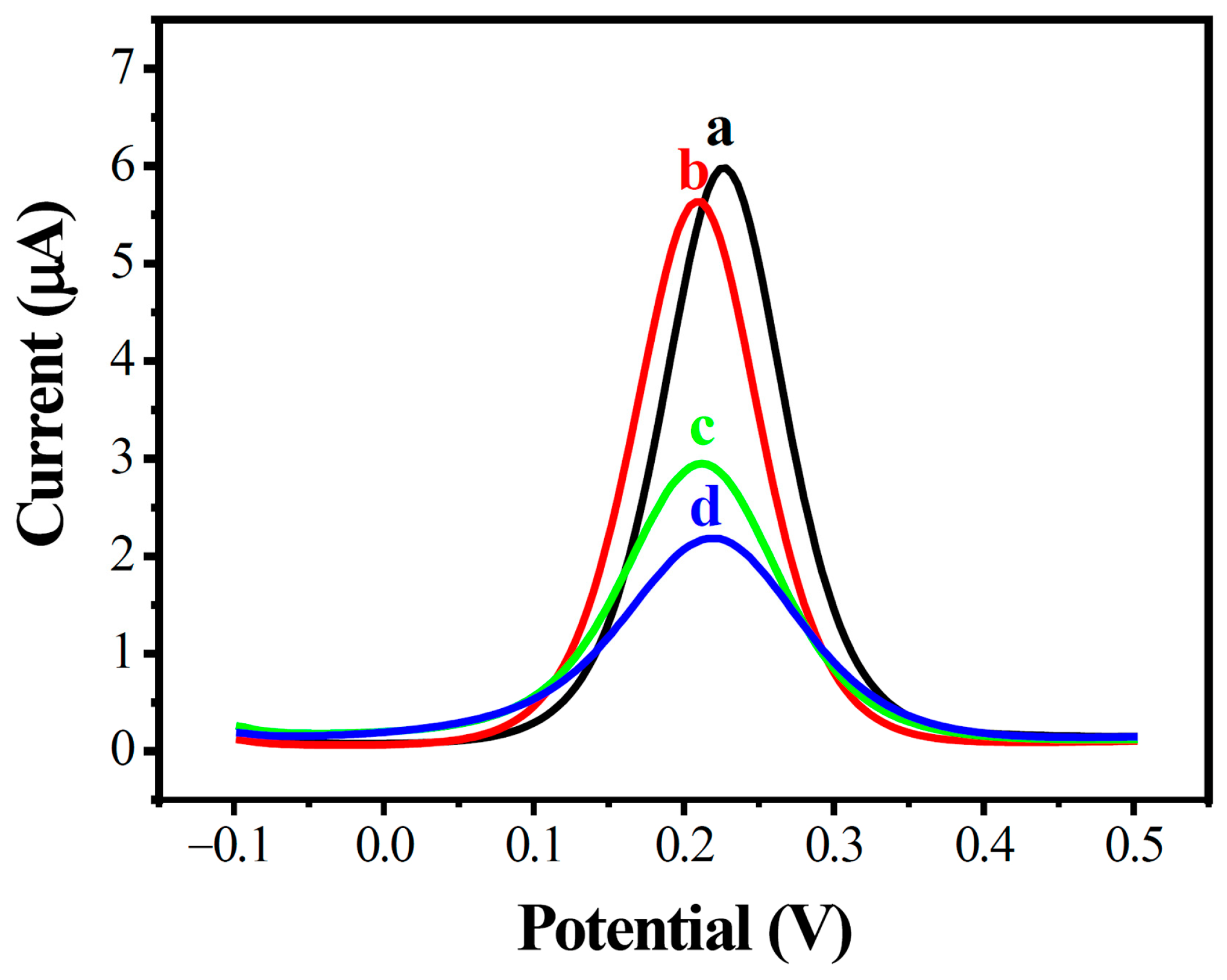
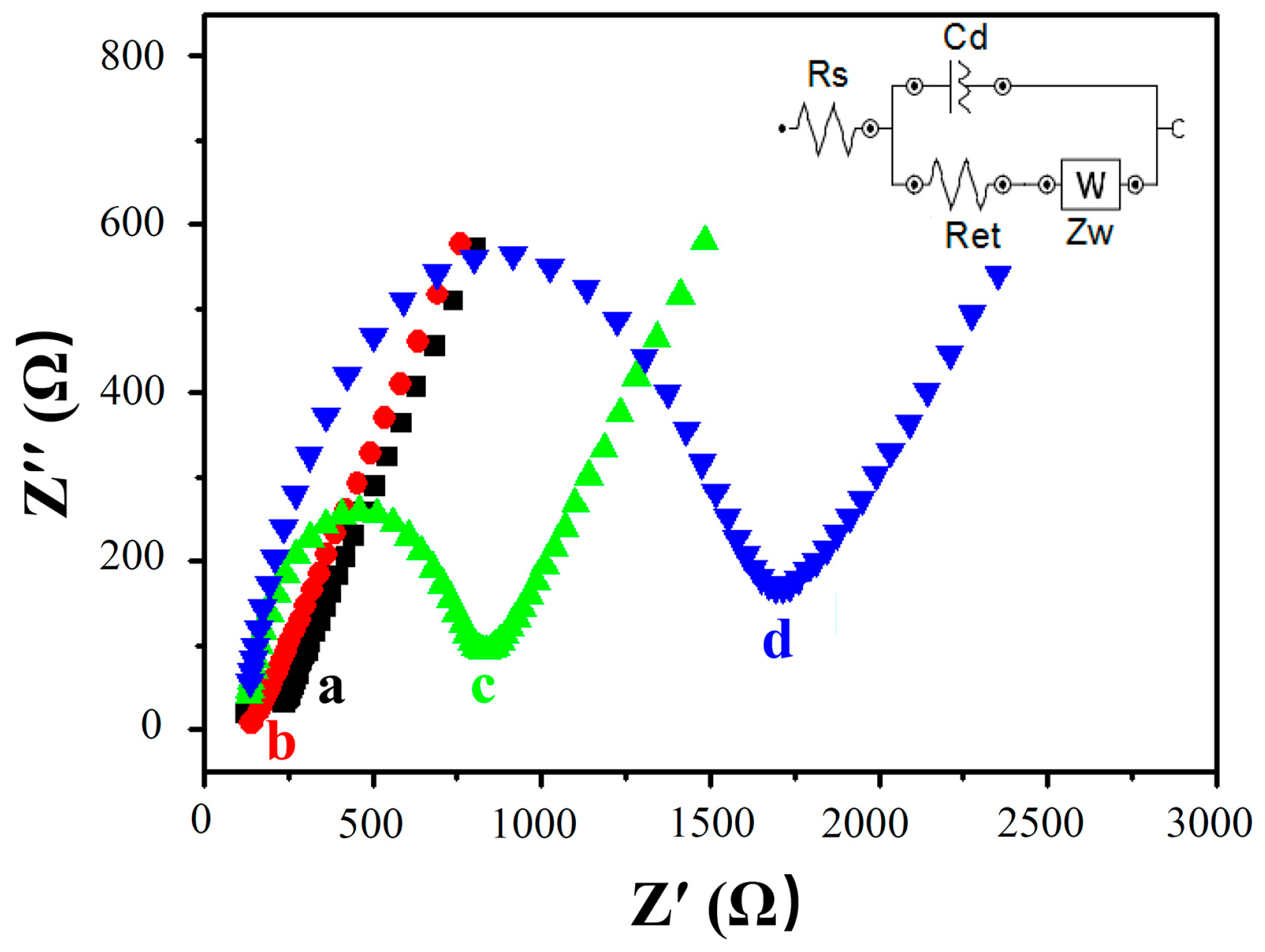
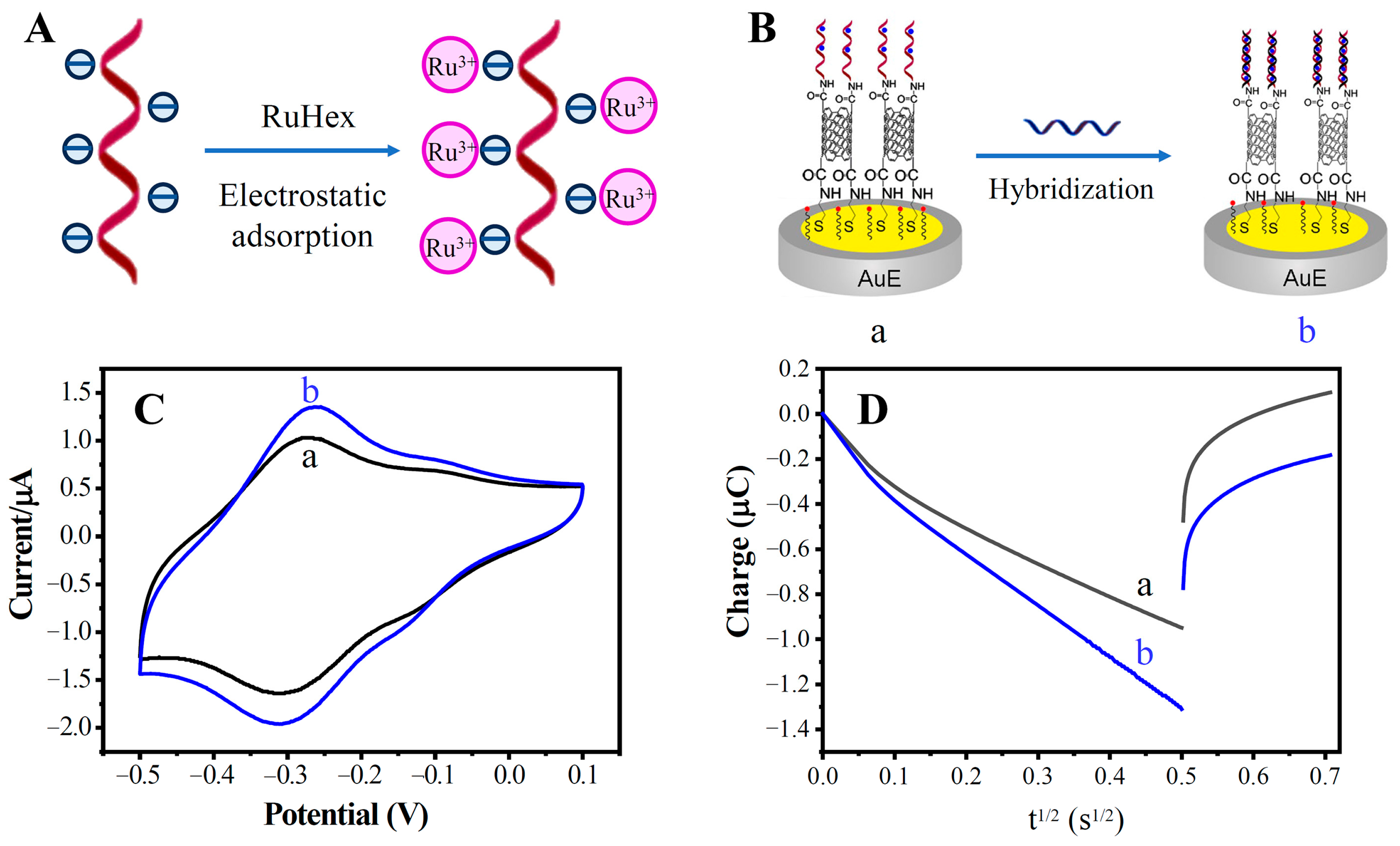

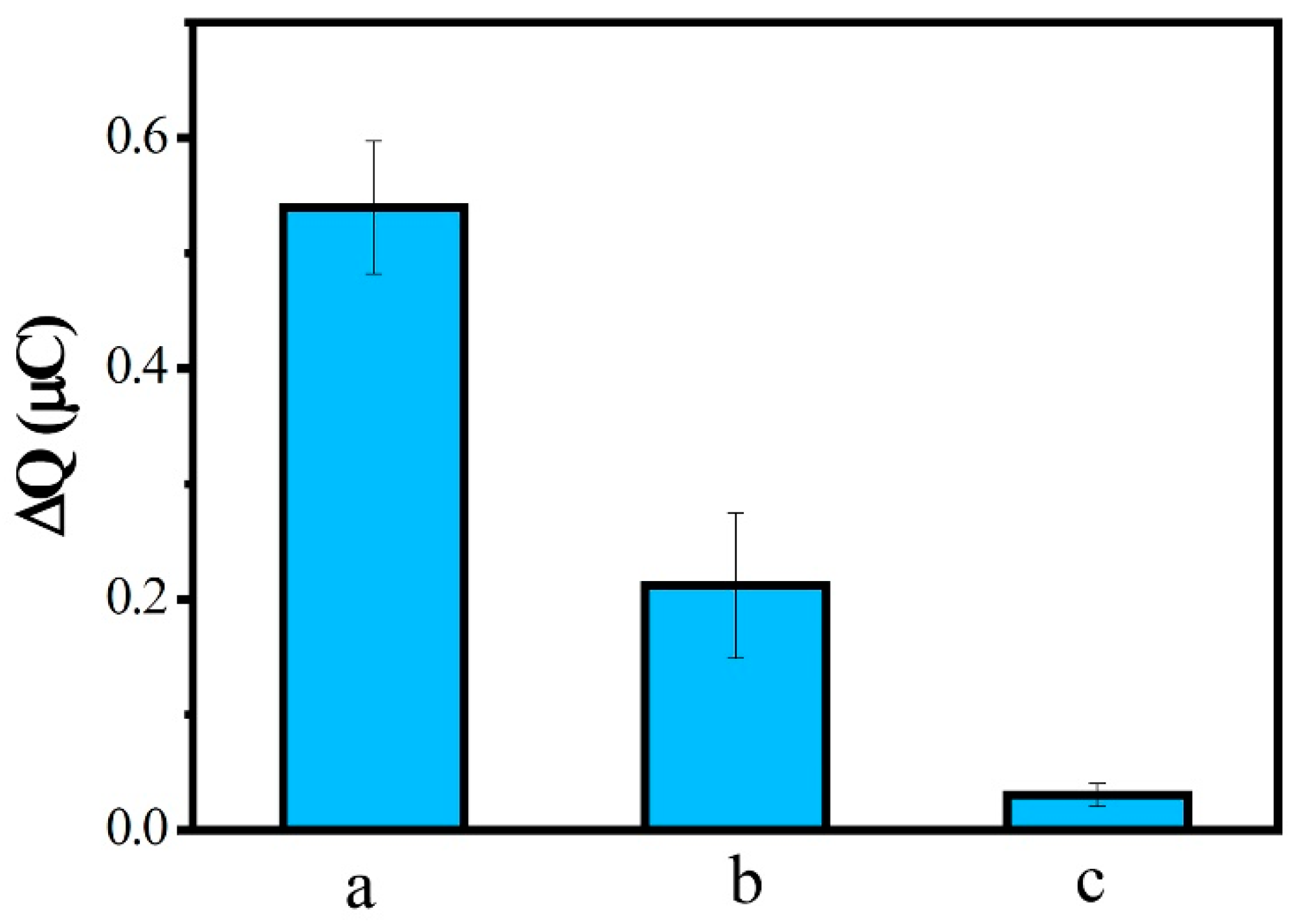
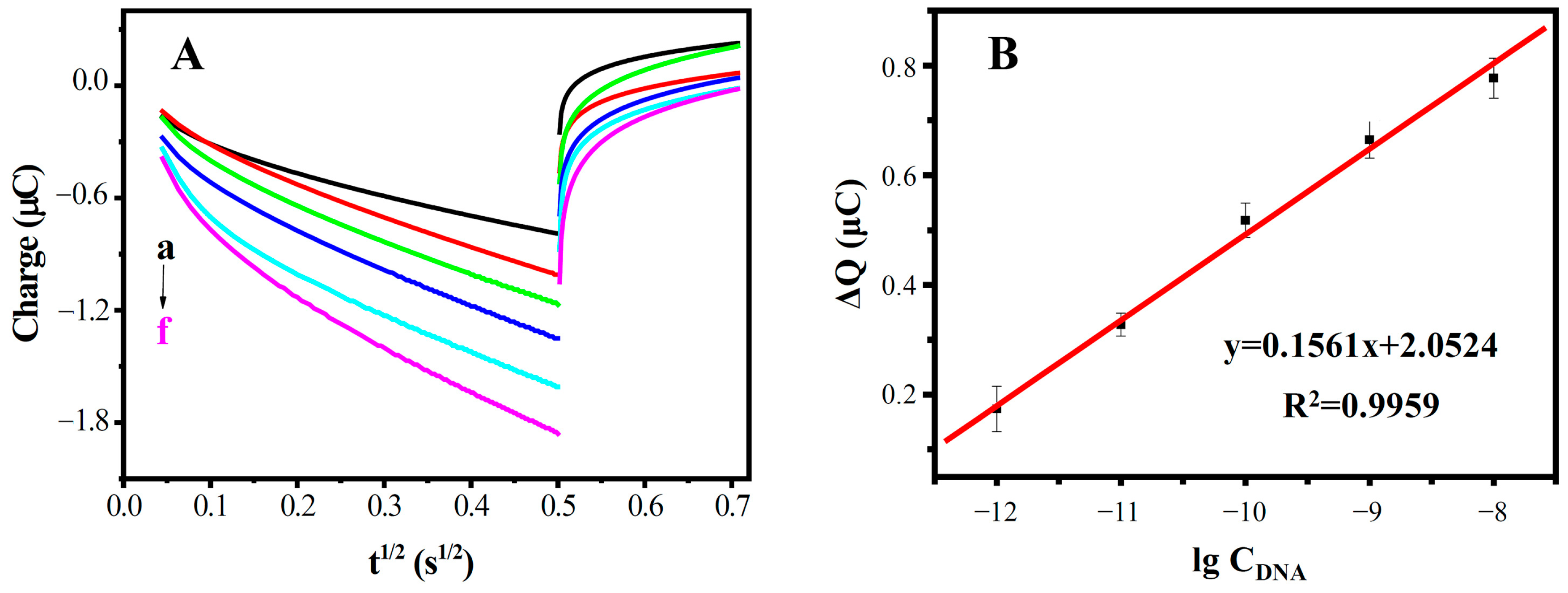
| Synthetic Oligonucleotide | DNA Sequences |
|---|---|
| Probe ssDNA-1 (P1) | 5’-NH2-(CH2)6-TTC CTT CTT ATC TTT TTC ACT TTT ATT GTT-3’ |
| Probe ssDNA-2 (P2) | 5’-SH-(CH2)6-TTC CTT CTT ATC TTT TTC ACT TTT ATT GTT-3’ |
| Complementary ssDNA | 5’-AAC AAT AAA AGT GAA AAA GAT AAG AAG GAA-3’ |
| One-base mismatch ssDNA | 5’-AAC AAT AAA AGT GAA AGA GAT AAG AAG GAA-3’ |
| Non-complementary ssDNA | 5’-CGA CCG TGC CTC AGC CTG CTA TCA CTA CCG-3’ |
| Modified Electrodes | Detection Method | Linear Range (M) | LOD (M) | Ref. |
|---|---|---|---|---|
| DNA-Tb(QS)3 | DPV | 3.0 × 10−8–1.85 × 10−7 | 2.1 × 10−8 | [12] |
| DNA/GO/CoFe2O4/ZnAl-LDH/FTO | DPV | 2.0 × 10−7–1.0 × 10−5 | 1.0 × 10−9 | [13] |
| Ni-MOF composite/AuNPs/CNTs | DPV | 1.0 × 10−8–1.0 × 10−6 | 1.3 × 10−10 | [14] |
| lambda exonuclease | EIS | 1.0 × 10−10–2.0 × 10−8 | 4.2 × 10−11 | [15] |
| Au NPs/TB–GO/GCE | DPV | 1.0 × 10−11–1.0 × 10−9 | 2.9 × 10−12 | [19] |
| DNA/MWCNTs/Cys/AuE | CC | 1.0 × 10−12–1.0 × 10−8 | 6.4 × 10−13 | This work |
Disclaimer/Publisher’s Note: The statements, opinions and data contained in all publications are solely those of the individual author(s) and contributor(s) and not of MDPI and/or the editor(s). MDPI and/or the editor(s) disclaim responsibility for any injury to people or property resulting from any ideas, methods, instructions or products referred to in the content. |
© 2023 by the authors. Licensee MDPI, Basel, Switzerland. This article is an open access article distributed under the terms and conditions of the Creative Commons Attribution (CC BY) license (https://creativecommons.org/licenses/by/4.0/).
Share and Cite
Chen, R.; Chen, H.; Peng, H.; Zheng, Y.; Lin, Z.; Lin, X. Multi-Walled Carbon Nanotube Array Modified Electrode with 3D Sensing Interface as Electrochemical DNA Biosensor for Multidrug-Resistant Gene Detection. Biosensors 2023, 13, 764. https://doi.org/10.3390/bios13080764
Chen R, Chen H, Peng H, Zheng Y, Lin Z, Lin X. Multi-Walled Carbon Nanotube Array Modified Electrode with 3D Sensing Interface as Electrochemical DNA Biosensor for Multidrug-Resistant Gene Detection. Biosensors. 2023; 13(8):764. https://doi.org/10.3390/bios13080764
Chicago/Turabian StyleChen, Ruiting, Hejing Chen, Huaping Peng, Yanjie Zheng, Zhen Lin, and Xinhua Lin. 2023. "Multi-Walled Carbon Nanotube Array Modified Electrode with 3D Sensing Interface as Electrochemical DNA Biosensor for Multidrug-Resistant Gene Detection" Biosensors 13, no. 8: 764. https://doi.org/10.3390/bios13080764
APA StyleChen, R., Chen, H., Peng, H., Zheng, Y., Lin, Z., & Lin, X. (2023). Multi-Walled Carbon Nanotube Array Modified Electrode with 3D Sensing Interface as Electrochemical DNA Biosensor for Multidrug-Resistant Gene Detection. Biosensors, 13(8), 764. https://doi.org/10.3390/bios13080764





